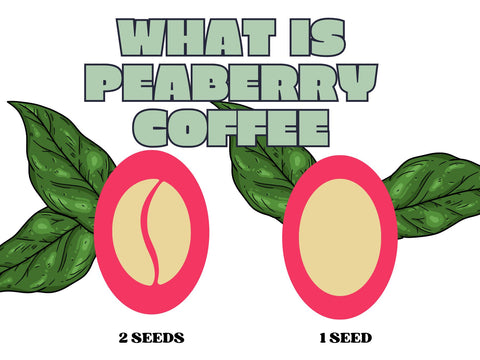Did you ever wonder why one cup of coffee can be so different from another cup? Many coffee drinkers know there are coffees, almost syrupy in consistency, and some that are thin, like tea. Some coffees have fruity notes; some have hints of chocolate or toffee.
You may think that it’s all down to the beans' origin and roast levels, but that’s only part of the reason. The coffee processing method is incredibly important for what coffee tastes like.
If you split a harvest but used different methods to process coffee, you’d get two very different coffees.
Let’s have a better look at what coffee processing is before we dive deeper into the topic of washed coffee.
What Is Coffee Processing?
Coffee processing turns coffee cherries into a bean that's ready to be turned into a cup of your favorite coffee! Washed and natural coffees are the most common results.
The fruit surrounding the coffee bean is removed, then the bean is dried. Natural processed coffees leave the coffee cherries intact and only remove the bean after the coffee cherries have dried with it inside.
Why Does Coffee Processing Matter?
The coffee processing method matters because it shapes its flavor and consistency. The washed method produces a clean and bright taste, while the natural coffee processing lets the bean soak up the fruity sweetness of coffee cherries.
In addition to those two, honey processed coffees are popular in Costa Rica. The honey process is a hybrid between naturally processed coffee and washed process coffee. It takes advantage of the sweet, sticky mucilage surrounding the coffee bean during drying.
In this article, we take a closer look at the washed method.
The Washed Process Method
The washed process is sometimes also called the wet process or fully washed method to distinguish between it and the semi-washed process clearly. Washed coffee is one of the most common coffee processing methods but the least sustainable because so much water is needed.
This process produces coffees with little to no aftertaste, bright acidity, clean flavors, and a distinct profile. The coffee beans' origin can really shine here.
Steps Involved For Washed Coffee
There are seven main steps involved in creating washed process coffees.
-
Harvesting and Sorting: Ripe coffee cherries are harvested from coffee trees. After the harvest, the cherries are sorted to remove damaged and separate ripe cherries from unripe cherries.
-
Pulping: The harvested cherries are then de pulped. This means the outer layer of the coffee cherry is removed. The coffee beans are left with a layer of mucilage which is important for a coffee’s natural sweetness.
-
Fermentation: During the next step, the coffee beans are fermented in a fermentation tank. This fermentation process helps to break down the mucilage. How long the beans are fermented differs from farm to farm, but the minimum is one or two days. Different countries use slightly different methods for this step.
-
Washing: After fermentation, the beans are washed in a water tank. The washing process is often repeated multiple times until the coffee farmers are satisfied.
-
Drying phase: After washing, the coffee beans are spread out in thin layers to dry evenly on raised beds. The drying process can occur naturally under the sun or with mechanical dryers. On some farms, beans dry naturally for a few days and then go into a mechanical dryer.
-
Sorting and Grading: The dried beans are sorted and graded based on size, density, and quality.
-
Packaging and Export
What Does Washed Coffee Taste Like?
Just like natural coffees, the flavor profile depends not only on the washed processing method but also on the bean’s origin and how the bean is roasted.
There are some differences when comparing washed vs natural coffees that stand out:
Washed coffee has a cleaner and more distinct flavor because less fermentation happens during the coffee processing. In addition, this coffee usually has a bright and lively acidity, whereas natural coffee is bolder and intenser.
Range of Flavors and Consistency
When drinking washed coffees, you can experience a range of flavors, from floral and fruity notes to more nuanced undertones like caramel, chocolate, or even herbal elements.
There's a difference in the body of natural and washed coffees. Washed coffees are a more delicate drink.
This coffee has a less pronounced sweetness than natural coffees, but many prefer how this subtle sweetness is balanced with the drink’s acidity and other flavor components.
After all, adding sugar to your cup is easy enough, but impossible to remove the natural sweetness.
What Are The Pros And Cons Of Washed Coffee?
As with everything, there are pros and cons you need to consider when you decide between coffee processing methods. It is up to each coffee drinker to weigh the following pros and cons against each other.
Pros
-
More control over the fermentation process.
-
Smaller risk for mold and spoilage.
-
Faster than dry processing.
-
A more consistent flavor.
-
Often considered higher quality.
-
Clean, bright flavor.
-
A more authentic coffee taste.
Cons
-
Not environmentally friendly.
-
Natural processing requires a lot of water.
-
Farmers need to buy specialized machinery.
-
Farmers need staff that can use the machinery.
-
The coffee’s body is sometimes too light/thin, like tea.
-
Smaller farms often can't afford the additional costs.
What Is The Difference Between Washed vs Semi Washed Coffee?
The semi-washed process is also known as the pulped natural process, wet hulling, or “Giling Basah” (Indonesian for “wet grinding”). As the name suggests, it’s closely related to washed coffee but involves fewer steps.
The semi-washed process is popular in some countries because it’s less labor-intensive and requires less water than washed coffee.
During the semi washed coffee processing, machines strip the outer skin from the cherries, leaving the coffee beans in their mucilage. After one day of drying, the mucilage is gently washed away in a water bath. The last step is drying in the sun or a drying machine.
How Do I Know If I am Buying Washed Coffee?
You may see the information on the coffee label depending on where you buy your coffee from. In addition to the coffee’s origin and roast level, it will say “fully washed” or “washed”.
However, many big commercial coffee sellers do not print this information on the label.
In that case, you have two options: Contact the seller or coffee shop, or take an educated guess based on the coffee’s consistency, flavor, and country of origin.
If the coffee comes from a country with a very dry, hot climate and limited access to water, you’re likely looking at natural coffee (but there are exceptions). Washed coffees often come from countries in Central and South America, East Africa, and parts of Asia.
If the coffee has a fairly thin consistency, you can be almost sure it’s a washed coffee, but not all cups are as thin as tea. A bright flavor with no or little aftertaste is a good indication of a washed coffee.
Conclusion
It’s impossible to say that either natural processed coffee, washed processing, or any other coffee process results in a better final cup profile. Of course, natural process coffee is the most sustainable, but especially larger farms are coming up with solutions to the wastewater problem, like using the organic matter in wastewater as fertilizer.
When it comes to flavor, it’s a matter of taste. Some coffee drinkers wouldn’t touch washed coffee, while others can’t handle the boldness of natural coffee. There are complex flavors in all specialty coffee beans, but some believe that natural coffee processing results in more complex flavors.
You’ll likely have to try a variety of coffees to find your favorite(s), but knowing how processing and roasting influence a coffee’s flavor helps along the way.



